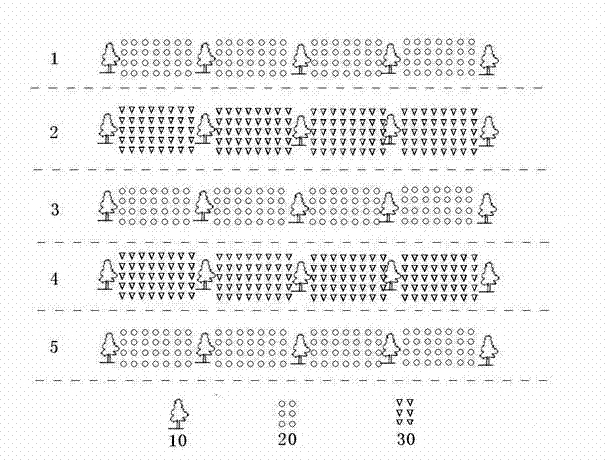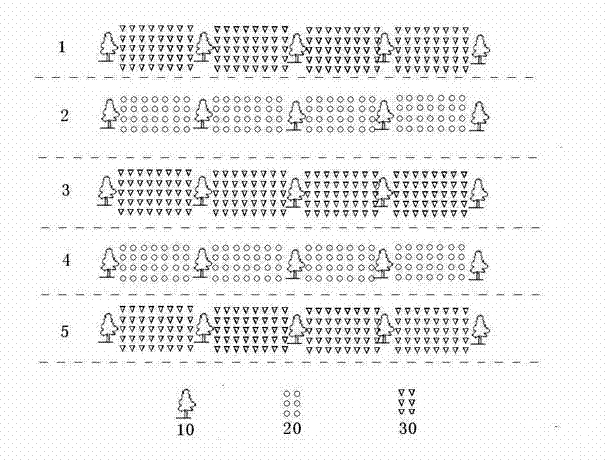Interplant method of camellia oleifera and torreya grandis young growth
A technology of torreya and camellia oleifera, applied in botany equipment and methods, horticulture, application, etc., can solve the problems of increased cost of shading, high cost of nitrogen fertilization, and high cost of shading nets, so as to reduce management costs, increase economic benefits, The effect of increasing the utilization rate of forest land
- Summary
- Abstract
- Description
- Claims
- Application Information
AI Technical Summary
Problems solved by technology
Method used
Image
Examples
Embodiment 1
[0028] See figure 1 with figure 2 , The specific steps of the interplanting method of young oil tea trees are:
[0029] 1) In the first year of transplantation of Camellia oleifera seedlings, in the land where young forests of Camellia oleifera have been planted, use horizontal belts to prepare land in winter and spring. All horizontal belts are fully cultivated, no weeds, and bamboo joint trenches are dug inside;
[0030] 2) When preparing the land, apply the decomposed farmyard manure 1000kg / mu, phosphate fertilizer 0-50kg / mu, N / P / K compound fertilizer 15-25kg / mu, spreading, covering 5-8cm;
[0031] 3) From mid-May to early June after site preparation and fertilization, between the rows of camellia seedlings, 20cm away from both sides of the seedlings of the camellia, the seedling of dry rice 20 and peanut 30 seeds in the hole, the sowing rate of dry rice 20 is 3-4kg / mu, and the row spacing is 15cm ×25cm, 5-10 grains per hole, 30 peanuts, double seeding, size 20cm×30cm, sown upla...
Embodiment 2
[0039] See figure 1 with figure 2 , The specific steps of the method of interplanting young torreya forests are:
[0040] 1) In the first year of transplanting torreya seedlings, in the land where the young forests of torreya seedlings have been planted, use winter and spring to prepare the ground along the horizontal belt, all the horizontal belts are fully cultivated, no weeds, and bamboo joint trenches are dug inside;
[0041] 2) When preparing the land, apply the decomposed farmyard manure 1000kg / mu, phosphate fertilizer 0-50kg / mu, N / P / K compound fertilizer 15-25kg / mu, spreading, covering 5-8cm;
[0042] 3) From mid-May to early June after site preparation and fertilization, between the rows of torreya seedlings, 20cm away from the two sides of the torreya seedlings, hole sowing upland rice 20 and peanut 30 seeds, upland rice 20 sowing rate is 3-4kg / mu, plant row spacing is 15cm ×25cm, 5-10 grains per hole, 30 peanuts, double seeding, size 20cm×30cm, sown upland rice 20 in the ...
PUM
 Login to View More
Login to View More Abstract
Description
Claims
Application Information
 Login to View More
Login to View More - R&D
- Intellectual Property
- Life Sciences
- Materials
- Tech Scout
- Unparalleled Data Quality
- Higher Quality Content
- 60% Fewer Hallucinations
Browse by: Latest US Patents, China's latest patents, Technical Efficacy Thesaurus, Application Domain, Technology Topic, Popular Technical Reports.
© 2025 PatSnap. All rights reserved.Legal|Privacy policy|Modern Slavery Act Transparency Statement|Sitemap|About US| Contact US: help@patsnap.com


